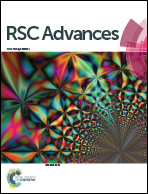A minimal structural variation can overcome tumour resistance of oxaliplatin: the case of 4,5-dehydrogenation of the cyclohexane ring†
Abstract
A new family of anticancer compounds has been derived from oxaliplatin by inserting a double-bond between carbons 4 and 5 of the 1,2-diaminocyclohexane ring. Testing against a panel of human tumour cell lines including cervical (A431), ovarian (2008), and colon carcinomas (HCT-15 and LoVo), and two oxaliplatin-resistant clones (LoVo OXP and LoVo MDR) has shown that the new compounds have, in general, equal if not better cytotoxic activity and are able to overcome the oxaliplatin-resistance. Moreover, the oxalato derivative induced lipid droplets increase in LoVo OXP cells thus suggesting the involvement of metabolism stress in its mechanism of action.



 Please wait while we load your content...
Please wait while we load your content...